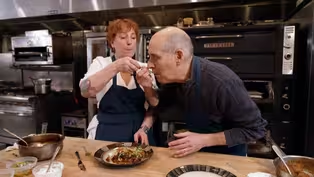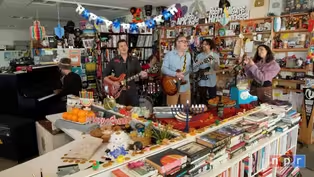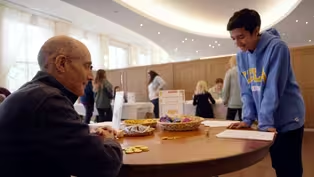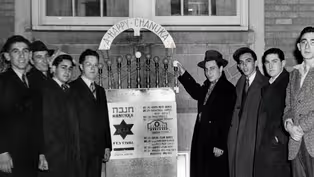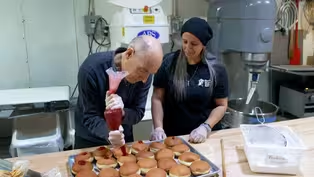
Lighting the Menorah
Clip: Special | 8m 32sVideo has Closed Captions
Why do Jewish families light a menorah at Hanukkah?
Why do Jewish people light a menorah at Hanukkah? Geoffrey explores the origins of the menorah, or hanukkiah, and the story behind public menorahs in the United States.
Problems playing video? | Closed Captioning Feedback
Problems playing video? | Closed Captioning Feedback
Chicago Tours with Geoffrey Baer is a local public television program presented by WTTW

Lighting the Menorah
Clip: Special | 8m 32sVideo has Closed Captions
Why do Jewish people light a menorah at Hanukkah? Geoffrey explores the origins of the menorah, or hanukkiah, and the story behind public menorahs in the United States.
Problems playing video? | Closed Captioning Feedback
How to Watch Chicago Tours with Geoffrey Baer
Chicago Tours with Geoffrey Baer is available to stream on pbs.org and the free PBS App, available on iPhone, Apple TV, Android TV, Android smartphones, Amazon Fire TV, Amazon Fire Tablet, Roku, Samsung Smart TV, and Vizio.
[Upbeat Music] During the Festival of Lights, sharing the miracle with others is what it's all about.
- That's a big theme of Hanukkah.
It's called pirsumei nisa You have to publicize the miracle.
That's why when we light Hanukkah candles, we light them in our windows.
That's why we light Hanukkah candles on the street.
Other holidays, were not so interested in the public side of it.
The Passover Seder is very much in the home, but Hanukkah, there is a special in Jewish law, a special command to publicize - pirsumei nisa - to let the whole world know about the power of light.
[Singing] Hanukkah Hanukkah.
Light the menorah These are members of the Orthodox Group, Chabad, which takes that command to the next level.
Each Hanukkah in cities around the country, they have a car top Menorah Parade.
This one in Chicago is just gearing up and they tell me it's more than a hundred cars long.
- Have you ever done this before?
No this is actually my first time and I'm really excited.
- Why are you excited?
- We're doing it all together and it feels like we're part of something bigger.
- Who makes these things?
Where do you get these from?
- So we actually made our own for many years.
- This year's model designed in Canada and manufactured in China is magnetic with energy efficient LED lights.
Was it hard to hook it up?
Took just a few seconds, shockingly.
- What's the message you're trying to send?
- The message is that we are bringing light to the world, positivity to the world.
We have to be proud that we're Jewish when it's out in the public square, that's the real feeling of Hanukkah.
- Today, in all 50 states, you can find menorahs and Hanukkah symbols in plain view.
Many even in front of government buildings and in public squares.
- If you look around the country and around the world at how many menorahs there are on Hanukkah in public, it's not something to take for granted.
- We grow up thinking that, you know, isn't this the way it always was, but it isn't the way it always was.
- Prior to the 1970s, Hanukkah was more low profile.
While another winter holiday, Christmas, was very much in the public eye.
- I can imagine for Jewish people who see nativity scenes in the town square or big crosses, right?
Or Christmas trees in the town square feels like a validation or a legitimization specifically of Christianity in what you know, they assume should have been a religiously neutral public space because there's been a long history by then of Jewish religious groups actually advocating against public symbols or signs of religious worship.
And Chabad goes in exactly opposite direction, right?
And they say, no, actually what we need to do is stake our claim in the public sphere alongside those other maybe majoritarian religious symbols, and to show that we are as equal, as legitimate, right as proud of our symbols as any other religious group is too.
- So in the 1970s, Chabad launched a campaign to shine a light on the miracle of Hanukkah and runs with it in probably ways that the Maccabees could only have dreamed of.
In 1974, Chabad of Philadelphia lit a four foot menorah in front of Independence Hall, which then housed the Liberty Bell, an icon of American freedom.
The following year, Chabad of San Francisco built a giant 22 foot mahogany menorah in the city's Union Square.
Other major cities followed suit with more and more Hanukah displays in public places.
This is the first night of the Jewish Festival of Hanukkah and New York City.
It took a cherry picker to light the world's largest menorah.
In 1979, Chabad took their campaign to the nation's capitol.
On the fourth night of Hanukkah in a park across from the White House president Jimmy Carter lit the first national menorah, - This national menorah.
In this way, we share the message of Hanukkah with the world at large - And menorahs have been lit by every president since, But some saw Chabads public menorahs as unconstitutional - In a pluralistic society like ours.
It's a very sticky question.
The point is to keep the state out of religion and religion out of the state A series of lawsuits eventually made their way to the Supreme Court, which ruled in favor of Chabad.
And the group's towering menorahs can still be seen in cities around the world.
But for most Jews, a humbler version does the job just fine.
- For each night of Hanukkah, there's eight nights.
We usually say the prayers, you know, and light the candles.
- So this is a bus menorah that we picked up somewhere along the way.
And being the the Busses, you know, everybody kinda gets a kick out of it.
- One, two, three!
At this synagogue, members brought their menorahs from home and they held way more than just candles.
What's the story?
Who made that?
- A relative of mine gifted me and my twin brother with menorahs that have our name on it, and every year since, I've got to light it.
So it has a lot of memories, has a lot of love, and a lot of love for the Jewish community.
- That's beautiful.
What's your brother's name?
- Samuel.
He got more letters.
- He got more letters!
- Wait, look.
It's an emoji menorah.
So what's the story of this?
Where did this come?
- He brought it with him from Russia when he was 10 in 1906.
- Your father?
- My my father.
- You light it every year?
- Yes.
- What does it make you think of when you light it?
- Right now?
I see my father.
This is a piano keyboard because I have been a pianist since I was five years old.
- How about that?
- It's really the thing that was closest to my heart and I thought would make the neatest personalized hanukkiah.
- Wait, did she say "hanukkiah?"
I thought it was called a menorah!
- A menorah is actually just a lamp.
So a menorah could be one branch, seven branches - In the ancient temple in Jerusalem.
The menorah had seven branches and the hanukkiah has eight to commemorate the eight days.
- I'm going like this because here I have made a hanukkiah.
It has- - Look at that.
- It has a helper candle in the middle called the shamash.
The shamash is used to light all of the other candles.
It's one candle that you, first you light that with how you light normal candles.
Then you pick it up.
You need to be careful.
Whoa!
Whoa!
It's gonna blow my face off!
And you light the rest.
We have three menorahs that we light every year.
- Oh, one of them... - Caught on fire - Burst into flames that year, caught on fire - Yeah.
- It was the flammable Play-Doh one.
But the the rest are still with us.
- This is the Menorah - hanukkiah - that we lit in my house when I was a kid growing up.
You know, for thousands of years, Jews have been lighting hanukkiot - that's the plural of Hanukkiah - at sundown.
on each of the eight nights of Hanukkah.
The traditions vary slightly depending on where in the world you are.
In India, for example, members of the Bene Israel community Light wicks dipped in coconut oil and eat onion fritters called kanda bhaji.
And in North Africa, the seventh night of Hanukkah is referred to as Chag HaBanot and includes a special candle lighting ceremony to honor women.
[Singing and drumming] But the idea of lighting eight nights in a row, that's a Hanukkah tradition that unifies Jews worldwide.
Celebrating Hanukkah in the United States
Video has Closed Captions
Clip: Special | 5m 46s | How do modern Jewish families celebrate Hanukkah? (5m 46s)
A Celebration of Hanukkah Trailer
Video has Closed Captions
Preview: Special | 1m 1s | Geoffrey Baer takes viewers on a fun exploration of the time-honored traditions of Hanukkah. (1m 1s)
Video has Closed Captions
Clip: Special | 5m 42s | Chef Mindy Segal demonstrates her latke recipe. (5m 42s)
Video has Closed Captions
Clip: Special | 4m 47s | Meet The LeeVees, a Hanukkah band behind the album “Hanukkah Rocks.” (4m 47s)
Video has Closed Captions
Clip: Special | 4m 15s | Geoffrey plays a game of dreidel. (4m 15s)
Video has Closed Captions
Clip: Special | 3m 52s | Geoffrey explores the story of the Maccabees and the history of Hanukkah. (3m 52s)
Video has Closed Captions
Clip: Special | 3m 21s | Geoffrey visits a bakery to learn about sufganiyot. (3m 21s)
Providing Support for PBS.org
Learn Moreabout PBS online sponsorshipSupport for PBS provided by:
Chicago Tours with Geoffrey Baer is a local public television program presented by WTTW


